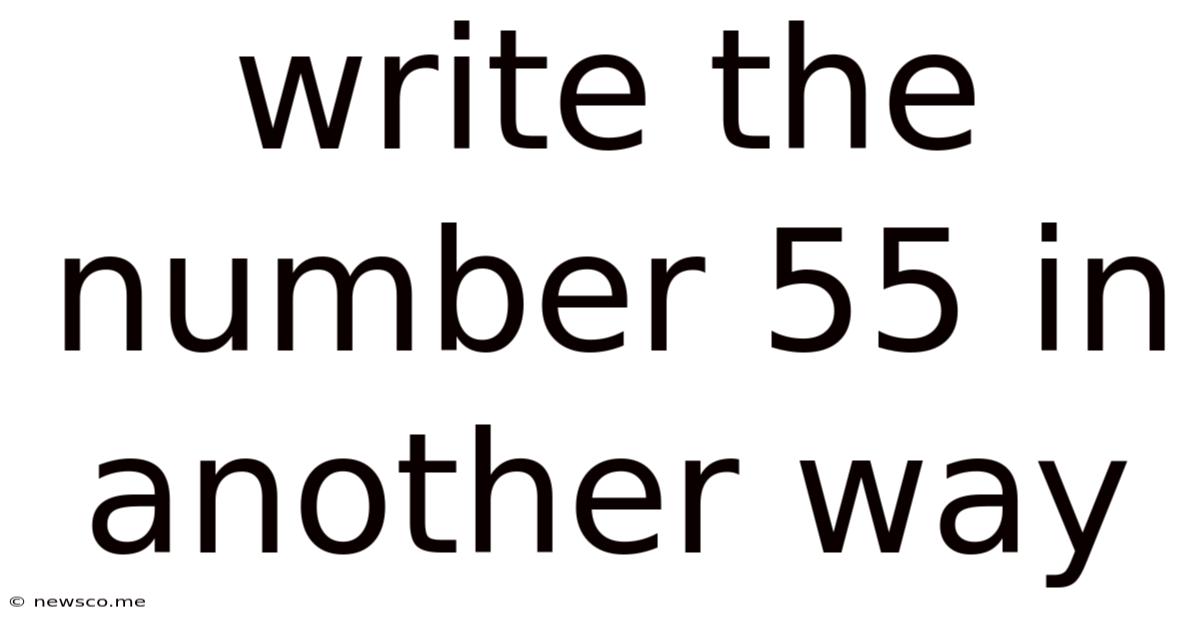Write The Number 55 In Another Way
News Co
Apr 22, 2025 · 4 min read

Table of Contents
Write the Number 55 in Another Way: A Deep Dive into Numerical Representations
The seemingly simple task of representing the number 55 differently opens a fascinating window into the world of mathematics, linguistics, and even computer science. While the Arabic numeral "55" is the most common representation, exploring alternative methods reveals the rich tapestry of numerical systems and their underlying principles. This article will delve into various ways to write the number 55, covering different number systems, word representations, symbolic representations, and even exploring its representation in code.
Number Systems Beyond Base 10
Our everyday number system is base-10, meaning it uses ten digits (0-9) and groups numbers in powers of 10. However, other number systems exist, each offering a unique way to express 55.
Binary (Base-2)
Binary, the language of computers, uses only two digits: 0 and 1. To convert 55 to binary, we repeatedly divide by 2 and record the remainders:
- 55 / 2 = 27 remainder 1
- 27 / 2 = 13 remainder 1
- 13 / 2 = 6 remainder 1
- 6 / 2 = 3 remainder 0
- 3 / 2 = 1 remainder 1
- 1 / 2 = 0 remainder 1
Reading the remainders from bottom to top, we get 110111₂. This is the binary representation of 55.
Octal (Base-8)
Octal uses eight digits (0-7). Converting 55 to octal involves repeated division by 8:
- 55 / 8 = 6 remainder 7
- 6 / 8 = 0 remainder 6
Therefore, 55 in octal is 67₈.
Hexadecimal (Base-16)
Hexadecimal uses sixteen digits (0-9 and A-F, where A=10, B=11, C=12, D=13, E=14, F=15). Converting 55 to hexadecimal:
- 55 / 16 = 3 remainder 7
- 3 / 16 = 0 remainder 3
Thus, 55 in hexadecimal is 37₁₆.
Roman Numerals
The Roman numeral system, an ancient system still used today for stylistic purposes, represents numbers using combinations of letters: I (1), V (5), X (10), L (50), C (100), etc. 55 in Roman numerals is LV.
Word Representations and Linguistic Nuances
Beyond numerical systems, expressing 55 involves language. The most straightforward approach is simply spelling out the number: fifty-five. However, variations exist across languages and dialects. For example, in Spanish, it's cincuenta y cinco. Exploring different languages opens a linguistic perspective on numerical representation. The choice of words depends entirely on the language used, showcasing the diversity of human communication.
Symbolic and Mathematical Representations
Moving beyond standard numerical and linguistic representations, we can explore more abstract ways of expressing 55.
Sum of Consecutive Numbers
55 can be expressed as the sum of consecutive numbers: 1 + 2 + 3 + 4 + 5 + 6 + 7 + 8 + 9 + 10 = 55. This highlights a property of triangular numbers.
Factorization
55 can be factored into its prime factors: 5 x 11. This representation is crucial in number theory and cryptography.
Set Theory
In set theory, 55 can be represented as a set containing 55 elements. For instance, {1, 2, 3, ..., 55}. This demonstrates the connection between numbers and the concept of cardinality.
Geometric Representations
While less common for larger numbers, one could visually represent 55 using geometric shapes. For example, arranging 55 dots in a specific pattern, or constructing a geometric figure with 55 units. This emphasizes the link between numbers and spatial representation.
Representing 55 in Programming
Computer programming provides yet another lens through which to view 55.
Different Data Types
In programming, the number 55 can be represented using various data types, such as:
- Integer: The most straightforward way, storing 55 as a whole number.
- Floating-point: Representing 55.0, allowing for decimal precision, although unnecessary in this case.
- String: Storing "55" as a text string. This is useful for display purposes or when numerical operations aren't needed.
Code Examples (Illustrative - No Execution Intended)
The following code snippets illustrate how 55 might appear within different programming contexts (these are illustrative and may not compile without a full program):
Python:
number = 55
string_representation = "55"
JavaScript:
let num = 55;
let strNum = "55";
C++:
int number = 55;
std::string strNum = "55";
These examples show how 55 can be stored and manipulated within a computer program, depending on the desired application.
Conclusion: The Multiplicity of Representation
This exploration reveals that the seemingly simple number 55 has a surprisingly rich and multifaceted range of representations. From the familiar base-10 system to the binary language of computers, through Roman numerals, linguistic expressions, and mathematical properties, the ways to express 55 highlight the versatility and depth of numerical systems. This diverse perspective extends into the realm of programming, where data type choices further expand the possible representations. The journey of understanding "how to write the number 55 in another way" transcends simple numerical manipulation; it's a journey into the fundamental nature of numbers and their diverse applications across various fields of study and technology. This understanding is crucial for anyone seeking a deeper appreciation for mathematics and its role in our world.
Latest Posts
Related Post
Thank you for visiting our website which covers about Write The Number 55 In Another Way . We hope the information provided has been useful to you. Feel free to contact us if you have any questions or need further assistance. See you next time and don't miss to bookmark.